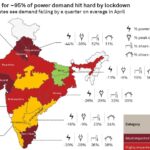Electricity demand shrank nearly a quarter in April 2020 as commercial and industrial activity switched off majorly following the nationwide lockdown. For states with ample skin in manufacturing – such as Uttarakhand, Gujarat, Haryana, and Tamil Nadu – demand dimmed a significant 30-50%, accordingly to CRISIL.
Put another way, that is like experiencing a total blackout every alternate or third day!
The upshot? Power demand growth, which was already feeble last fiscal, could trip to de-growth this fiscal. That said, there was some offset because about 1.4 billion people stayed at home, of which millions also worked from home, leading to a surge in domestic electricity consumption via more recharging of devices, more videos streamed, more online content consumed, and more cooking at home (often involving use of electrical appliances).
That cushioned the slack-demand blow for Andhra Pradesh, Bihar, Odisha and Haryana in particular, which have a substantial domestic-consumer base.
Lower demand from industrial users, who pay the highest tariffs and cross-subsidise domestic and agricultural users, would hit the revenues of discoms.
Sector recovery will be a function of how quickly economic activity replugs, reboots and resurges.
Spot prices of electricity, which have been surging of late, will continue to rise in the near term driven by both structural and seasonal reasons.
These include unmet and suppressed demand, no new thermal capacities announced in the past 2 years, and inability to meet peak demand because of mismatch with renewable energy generation curve and insufficient domestic coal supplies. Moreover, plants stressed owing to ongoing litigation and change in law provisions, are unable to run at full capacity, thereby adding to supply constraints.
The monthly market clearing price at the Indian Energy Exchange (IEX) has spiked ~25% from Rs 3.20per unit in January this year to Rs 3.97 in March, taking the average cost to Rs 3.43. That’s a huge leap from the ~Rs 2.50 average logged in the corresponding period of the past two fiscals.
What’s more, monthly peak prices on power exchanges this year have averaged at Rs. 7.1 which is almost twice the levels in fiscal 2017.

